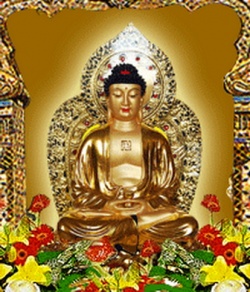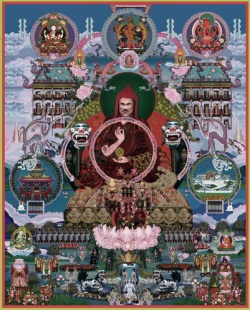The term 'Buddhism
The term 'Buddhism' refers to a vast and complex religious and philosophical tradition with a history that stretches over some 2,500 years, taking in, at one time or another, the greater part of Asia, from Afghanistan and parts of Persia in the west to Japan in the east, from the great islands of Sumatra and Java in the south to Mongolia and parts of southern Russia in the north.
As one writer reminds us, over half the world's population today lives in areas w:here Buddhism has at one time or another been the dominant religious influence.1 Living Buddhism divides into three broad traditions:2 ' I. The Theravada tradition of Sri Lanka and South-East Asia, also sometimes referred to as 'southern' Buddhism. Its canonical scriptures are preserved in Pali, an ancient Indian language closely related to Sanskrit.
The school exemplifies a certain conservatism. Relative to the other two traditions, it can be regarded as generally closer in doctrine and practice to ancient Buddhism as it existed in the early centuries BCE in India. Today it is the religious tradition followed by a population of over IOO million in Sri Lanka, Burma, Thailand, Cambodia, and Laos. 2. The East Asian tradition of China, Korea, Japan, and Vietnam, also sometimes referred to as 'eastern' Buddhism.
Its scriptures are preserved in Chinese and its general outlook is that of the Mahayana or 'Great Vehicle', a movement of ancient Indian Buddhist thought and practice that from about the beginning of the Christian era dubbed those who did not adopt its overall vision of Buddhism-represented today by the Theravada-followers of the 'Lesser Vehicle' (hinayiina). East Asian Buddhism is extremely diverse; it has coexisted with Confucianism, Taoism, Shinto, and, more recently but less happily, Communism; it remains a significant religious tradition for a population of soo million to I,ooo million.
The Tibetan tradition, also sometimes referred to as 'northern' Buddhism. Its scriptures are preserved in Tibetan and once more its outlook is broadly that of the Mahayana, but its i:nore specific orientation is that of the 'Vehicle of the Diamond Thunderbolt' (vajra-yiina), also known as Tantric Buddhism, Today it is the religious tradition followed by IO million to 20 million, principally in Tibet and Mongolia, but also in parts of Nepal and Himalayan India. All three of these traditions look back to ancient Buddhism and the land of India, where Buddhism was born but whence it virtually disappeared over five centuries ago. ·
The present volume was conceived as an introduction to Buddhist thought and practice, and is intended to be accessible to the reader with no previous knowledge of Buddhism. Given its great diversity and its long history, the task of introducing Buddhism is a daunting one. As is fashionable to point out these ·days, 'Buddhism' is something of an intellectual abstraction: in reality there is not one Buddhism but many Buddhisms. Any writer of an introductory text to Buddhism is faced with the problem of how to do justice to the richness and diversity of ~Buddhism both past and present.
Most of the existing introductory volumes to Buddhism offer their readers some kind of general survey of the different 'Buddhisms', and attempt to give an equal and balanced treatment of all that Buddhism has been and still is. The advantage of this approach is that, ideally if not always in practice, it avoids the pitfall of seeming to imply that one or other form of Buddhism represents a 'truer' form of Buddhism than others, or that one has somehow captured the real essence of Buddhism. Its disadvantage is that, in a volume of some 300 pages, one is in danger of saying very little about an awful lot, and of presenting the reader with what amounts to a catalogue of dates, people, places, doctrines, and practices; a reader may finish such a book, yet somehow know very little of Buddhism.
For this reason it seems worth while trying to introduce Buddhism in a more explicitly focused way. The approach I have adopted in the present volume, then, is to try to identify and focus on those fundamental ideas a,nd practices that constitute something of a common heritage shared by the different traditions of Buddhism that exist in the world today. Of course, the precise nature of that common heritage is open to question. Nevertheless, the fact remains that the areas of Buddhist thought and practice outlined in the present volume -the story of the Buddha (Chapter 1), a textual and scriptural tradition , the framework of the four noble truths , the monastic and lay ways of life , a cosmology based around karma and rebirth , the teaching of no self and dependent arising , a progressive path of practice leading on from good conduct. and devotions through stages of meditation to a higher understanding , the theoretical systems of either the Abhidharma or the Madyamaka and Yogacara , the path of the bodhisattva -are all, in one way or another, assumed by and known to all Buddhism. These are the foundations upon which Buddhism rests. Of course, I do not mean to suggest by this that a Buddhist layman in Tokyo and a Buddhist laywoman in Bangkok, that a monk in Colombo and a nun in Lhasa, would all respond to questions on these topics precisely along the lines set out in the relevant chapters below. None the less, it is not unreasonable nor, I think, is it to commit oneself to an essentialist view of Buddhism to suggest that, whatever the nature of the Buddhist terrain, one cannot dig much below the surface without coming across some trace of the patterns of thought and practice outlined here, even if at different times and in different places the constructions built on their foundations present their own distinctive and peculiar aspects. Moreover, the fact that those patterns of thought and practice are not immediately apparent does not of itself mean that they exert no influence. That we may not always be consciously aware of particular ideas and theories, or that we may be unable to articulate them in detail, does not mean that those ideas fail to affect our view of the world.
The principles of, say, Newtonian physics, Darwinian evolutionary theory, and Freudian psychology contribute to a world-viewthat is shared by many who have never read a word of what Newton, Darwin, or Freud wrote and would be hard pressed to explain in detail any of their ideas. I should, however, add that I have not entirely eschewed the general-survey approach; Chapter 9, on specifically Mahayana ideas, and especially , an overview of the history of the different traditions of Buddhism in Asia, are intended to give some indication of what I have not covered and provide some form of orientation for further study.
Apart from its simply allowing a more sustained account of some significant aspects of Buddhist thought and practice, there is a further reason why I think focusing on the common heritage as indicated above is appropriate at the introductory level: it affords a perspective on the development of Buddhist thought and practice which calls into question what might be dubbed the standard 'textbook' view and is in fact more in tune with recent scholarship. This textbook view tends to see the history of Buddhism in terms of a division into two major 'sects': the Theravada and the Mahayana.
More specifically, according to this 'textbook' view, in origin the Mahayana was at once a popular religious protest against the elitist monasticism of early Buddhism and a philosophical refutation of its dead-end scholasticism; moreover,this religious protest and philosophical refutation rapidly all but marginalized earlier forms of Buddhism. The research published in the last twenty years or so has increasingly made such a view of the development of Indian Buddhist thought and practice untenable.
The Mahayana did not originate as a clearly defined 'sect' and, far from being a popular lay movement, it seems increasingly likely that.it began as a minority monastic movement and remained such for several hundred years, down to at least the fifth century CE. Moreover, what is becoming clearer is that many elements of Buddhist thought and practice that were once thought to be characteristic of the emerging Mahayana were simply developments within what has been called by some 'mainstream' Buddhism; and while the Mahayana certainly criticized aspects of mainstream Buddhist thought and practice, much more was taken as said and done, and just carried over.
Thus, instead of seeing Mahayana as simply superseding earlier forms of Buddhism in India, the approach adopted in the present volume is to try to focus on the common ground between the non-Mahayana and Mahayana in the formative phase of Indian Buddhist thought and practice, and by referring to both the Pali sources of Sri Lanka and the Sanskrit sources of northern India to present an outline of 'mainstream' Buddhist thought and practice as the foundations for developments in India and beyond. Such an approach, then, does tend to privilege what is ancient, but throughout· I have attempted to give some indication of how these basic principles of Buddhist thought and practice might relate to more recent developments. Let me add here a few words on my specific approach to my material.
In describing Buddhist thought and practice, my aim has been, in the first place, simply to act as spokesman for its principles, and to try to articulate those principles as Buddhist tradition itself has understood them. In the second place, I have tried to give some indication of and pass some comment on the critical and scholarly issues that have emerged in the modern academic study of Buddhism over the last rso years or so. Some might question the need for yet another introductory volume on Buddhism, yet as a teacher of introductory courses on Buddhism at a university I find myself somewhat dissatisfied with the available teaching materials. Certainly there are available a number of survey-type books ranging from short and sketchy to more moderate-sized treatments.
In addition there are some solid introductions to various aspects of Buddhism -the social history of Theravada, Mahayana thought, Chinese Buddhism, Tibetan Buddhism-but if one looks for a volume giving a more focused account, reflecting recent scholarship, of what, for want of a better expression, one might refer to as the principles of 'mainstream' Buddhist thought and practice, there appears to be a gap. It is hoped that the present work will go some way to filling that gap. In sum, what distinguishes the present volume is that it contains rather more sustained expositions of Buddhist cosmology, no self and dependent arising, the path of meditation, and the theoretical Abhidharma framework (which underlies all later Buddhist thought) than other introductory books. Thus there is material here which, although basic from a Buddhist point of view, is only available in specialized books and articles. I hope, then, that while the book is intended to be accessible to the novice, there may also be something here for the elders of Buddhist studies.



